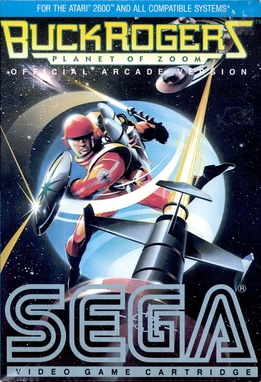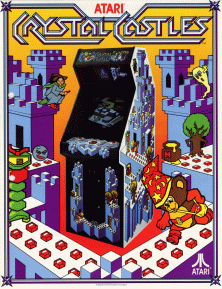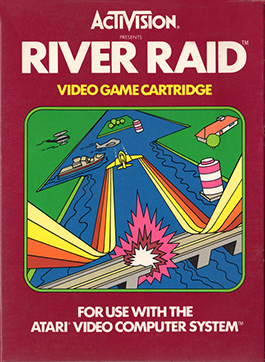
Asteroids is a space-themed multidirectional shooter arcade video game designed by Lyle Rains and Ed Logg released in November 1979 by Atari, Inc. The player controls a single spaceship in an asteroid field which is periodically traversed by flying saucers. The object of the game is to shoot and destroy the asteroids and saucers, while not colliding with either, or being hit by the saucers' counter-fire. The game becomes harder as the number of asteroids increases.

The Starpath Supercharger is an expansion peripheral cartridge created by Starpath, for playing cassette-based proprietary games on the Atari 2600 video game console.

Solaris is a space combat video game for the Atari 2600 published in 1986 by Atari. The game involves a player seeking out the planet Solaris via their starship. To accomplish this, the player must navigate the galactic scanner to explore quadrants of a map. Doing so allows them to explore Federation planets to refuel their ship, and engage in combat with hostile aliens known as the Zylons.

Berzerk is a multidirectional shooter designed by Alan McNeil and released for arcades in 1980 by Stern Electronics of Chicago. Following Taito's Stratovox, it is one of the first arcade video games with speech synthesis. Berzerk places the player in a series of top-down, maze-like rooms containing armed robots. Home ports were published for the Atari 2600, Atari 5200, and Vectrex.

Jr. Pac-Man is an arcade video game developed by General Computer Corporation and released by Bally Midway on August 13, 1983. It has the same gameplay as prior entries in the series, but the maze in Jr. Pac-Man scrolls horizontally and has no escape tunnels. The bonus item which moves around the maze changes dots into a form which slows Jr. Pac-Man as they are being eaten.

Buck Rogers: Planet of Zoom, known as Zoom 909 in Japan, is a pseudo-3D rail shooter released as an arcade video game by Sega in 1982. The player controls a spaceship in a third-person perspective, adapting the three-dimensional perspective of Sega's earlier racing game Turbo (1981) for the space shoot 'em up genre. It uses the Buck Rogers license, referencing the space battles, though Buck himself is never seen.

Crystal Castles is an arcade video game released by Atari, Inc. in 1983. The player controls Bentley Bear who has to collect gems located throughout trimetric-projected rendered castles while avoiding enemies, some of whom are after the gems as well.

Phoenix is a fixed shooter video game developed for arcades in Japan and released in 1980 by Taito. The player controls a space ship shooting at incoming enemies that fly from the top of the screen down towards the player's ship. There are five stages which repeat endlessly. The fifth is a fight against a large enemy spaceship, making Phoenix one of the first shooters with a boss battle, an element that would become common for the genre.

Combat is a 1977 video game by Atari, Inc. for the Atari Video Computer System. In the game, two players controlling either a tank, a biplane, or a jet fire missiles at each other for two minutes and sixteen seconds. Points are scored by hitting the opponent, and the player with the most points when the time runs out wins. Variations on the gameplay introduce elements such as invisible vehicles, missiles that ricochet off of walls, and different playing fields.

Alien is a 1982 maze video game for the Atari 2600 published by Fox Video Games. The game has the player control a human moving through the hallways of a space ship avoiding the adult alien and destroying the small alien eggs.

River Raid is a video game developed by Carol Shaw for the Atari Video Computer System and released in 1982 by Activision. The player controls a fighter jet over the River of No Return in a raid behind enemy lines. The goal is to navigate the flight by destroying enemy tankers, helicopters, fuel depots and bridges without running out of fuel or crashing.

In the history of video games, the second-generation era refers to computer and video games, video game consoles, and handheld video game consoles available from 1976 to 1992. Notable platforms of the second generation include the Fairchild Channel F, Atari 2600, Intellivision, Odyssey 2, and ColecoVision. The generation began in November 1976 with the release of the Fairchild Channel F. This was followed by the Atari 2600 in 1977, Magnavox Odyssey² in 1978, Intellivision in 1980 and then the Emerson Arcadia 2001, ColecoVision, Atari 5200, and Vectrex, all in 1982. By the end of the era, there were over 15 different consoles. It coincided with, and was partly fuelled by, the golden age of arcade video games. This peak era of popularity and innovation for the medium resulted in many games for second generation home consoles being ports of arcade games. Space Invaders, the first "killer app" arcade game to be ported, was released in 1980 for the Atari 2600, though earlier Atari-published arcade games were ported to the 2600 previously. Coleco packaged Nintendo's Donkey Kong with the ColecoVision when it was released in August 1982.

Save Mary is a prototype video game designed by Tod Frye and made for the Atari 2600. The game involves Mary who is trapped in a valley that is slowly filling with water. The player must operate a crane to move blocks to allow Mary to escape the rising water and eventually be carried to safety by the player.
Stunt Cycle is an arcade video game by Atari, Inc., originally released in 1976. In the style of the Evel Knievel craze of the mid-1970s, the game allows the player to perform simulated motorcycle jumping stunts. The arcade cabinet is modeled like a real motorcycle handlebar, and the player twists the right side for acceleration. The monitor is a 19-inch black and white cathode-ray tube with a black and white overlay. It accommodates 1 player or 2 players alternating.

Planet of the Apes is an American science fiction media franchise consisting of films, books, television series, comics, and other media about a post-apocalyptic world in which humans and superintelligent apes clash for control. The franchise started with French author Pierre Boulle's 1963 novel La Planète des singes, translated into English as Planet of the Apes or Monkey Planet. Its 1968 film adaptation, Planet of the Apes, was a critical and commercial hit, initiating a series of sequels, tie-ins, and derivative works. Arthur P. Jacobs produced the first five Apes films through APJAC Productions for distributor 20th Century Fox; following his death in 1973, Fox controlled the franchise.

Revenge of the Beefsteak Tomatoes is a video game for the Atari 2600 written by John Russell, and published by Fox Video Games, Inc. in 1983. Upon its release in 1983, the game cost roughly $30.

Yars' Revenge is a video game released for the Atari 2600 in 1982. It was created by Howard Scott Warshaw and is Atari's best-selling original game for the 2600.

Planet of the Apes is a 2001 action-adventure video game in the Planet of the Apes franchise. The franchise's first video game, it was released as a tie-in to the 2001 Planet of the Apes film, though the plot is inspired by Pierre Boulle's 1963 novel and the 1968 film adaptation. Fox Interactive contracted Visiware to develop the game for Windows and PlayStation and partnered with Ubi Soft as co-publisher. Torus Games developed a Game Boy Advance and Game Boy Color versions, which are based on the 1968 film and its 1970 sequel.

Dishaster is an action game released for the Atari 2600 in 1983 by Zimag. Another version of the game was released by Bit Corporation under the name Dancing Plates which features oriental-themed graphics and adds eight game variations.

Pigs in Space is a three-in-one 1983 video game developed and published by Atari, Inc. for the Atari 2600. It is based on the "Pigs in Space" sketch series on the then-popular television series The Muppet Show. The game is the last in a series of children-friendly games developed by Atari for the Atari 2600. Atari marketed the games as being good for the development of hand-to-eye coordination.



















